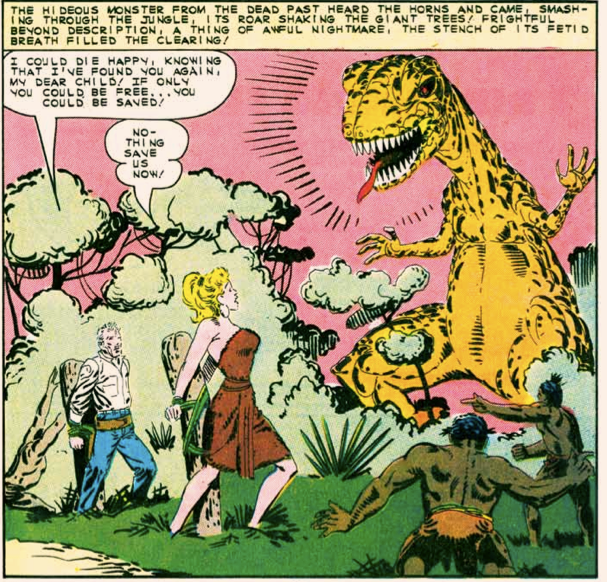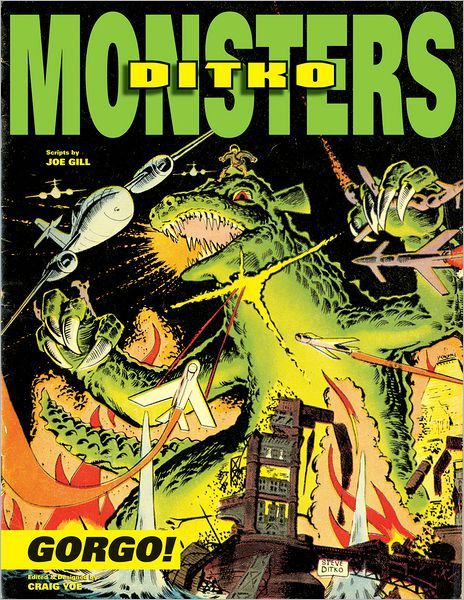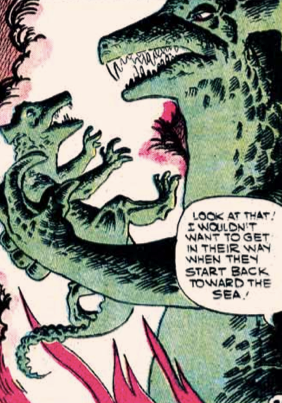If one were writing a history of film, 1961's Gorgo would barely merit a footnote, if that. Even if one were writing a history of monster movies, Gorgo likely wouldn't get much attention, perhaps only being mentioned in relation to King Kong, Godzilla or the original Lost World, all of which obviously influenced parts of the film.
So if it's such a relatively minor work in its own medium, what makes it important to comics art scholars and connoisseurs? Well, it earned its own comic book series from Charlton between 1961 and 1965, much of which was drawn by Steve Ditko ... at the same time he was co-creating Marvel's flagship character Spider-Man and Dr. Strange, during what was one of the most fruitful periods of American mainstream comics-making.
That's the subject of Steve Ditko's Monsters Vol. 1: Gorgo, an IDW Publishing/Yoe Books effort that collects about 200 pages of the Joe Gill-written, Ditko-drawn Gorgo comics, after a fairly thorough introduction by Craig Yoe contextualizing them. (Those Gorgo comics by other artists like Joe Sinnott and Vince Colletta are likely also worthy of revisiting, but outside the scope of this book, which is devoted to Gorgo as part of Ditko's career, not the other way around.)
Gorgo, whom you may have met through an episode of Mystery Science Theater 3000, is a Godzilla-like, man-in-a-suit monster, a humanoid lizard distinguished from his Japanese cousin by the big fins on his head. Awoken by volcanic activity, he's captured off the coast of Ireland by salvagers and sold to a London-based circus before the startling revelation that, as monstrous as Gorgo is, he's actually just an infant. His titanic mother comes to his rescue, wrecking every London landmark she could get her hands on before scooping up her little one and heading back to the sea (Gorgo's mom is actually the monster who gets the most screen time, but I guess Gorgo's Mom isn't as snappy a title).
It's perhaps most notable for the location: You don't see quite so many giant monsters attacking London, certainly not compared to monster magnets like New York City or Tokyo (or any Japanese city, town or village, come to think of it).
Ditko drew comic the adaptation, which is essentially a 19-page, super-condensed version of the film. From there, the comics continue with a sort of bigger, better sequel, in which the monsters swim west and decide to settled down for a nap on the Transatlantic cable. This gets the attention of human beings and, inevitably, Gorgo and his mother go on a rampage in America, his mom giving New York City the same treatment she gave London, even shrugging off an H-bomb in the process.
The rest of the stories are slightly less epic, and generally follow the pattern of the young, curious Gorgo swimming away from his sleeping mother and getting in to trouble of some sort (often because corrupt humans want to exploit him in some way), and then Ditko-drawn destruction ensuing.
In one story, a Fidel Castro analog "Mandel Astro" has a mad scientist train Gorgo into a weapon he can use against his neighbors. Later, the actual Castro appears in a story in which Gorgo and his mom intervene and prevent the Cuban Missile Crisis by destroying the Soviet weapons installations. There's a story of a director who wants to make a movie featuring Gorgo a la King Kong (in which Ditko's artwork takes on a sharper, more exaggerated and yet more detailed style to reflect the comedy of the piece, which Yoe attributes to a studio partner ), and another in which he ventures into an African "Lost World" full of dinosaurs.
Things get pretty goofy before the end of the book, where a pair of stories have plots reminiscent of the old Atlas monster comics Ditko, Jack Kirby and others used to draw: One features a UFO-riding alien trying to weaponize Gorgo, the other giant plant-men created by radiation.
As giant-monster stories, they are mostly pretty fun, and Gill was pretty imaginative in coming up with different riffs on the basic story of humanity poking at the elemental force of the sea monsters until they were roused to poke back over and over, with the monsters becoming if not good guys, at least virtuous monsters with the good timing to destroy the bad guys rather than the good guys (and, in at least four of the stories here, they serve as catalysts for romance).
That is, of course, only part of the intent of the collection. The other is to bring Ditko's non-Marvel, non-DC work to greater prominence and attention (this is one of several Ditko-focused books Yoe Books has produced) , and it certainly does that. While each story revolves around a pair of giant monsters, within that stricture Gill and Ditko play with genres and locations so there are war stories, horror stories and at least one comedy story. There are jungles and sea locations, President Kennedy, dinosaurs, a dolphin, cavemen, unfortunate racial stereotypes, a Victorian-looking explorers club or two, tons of missiles and the aforementioned alien and plant-men. There's a lot of stuff in here, basically, and it's interesting to see how Ditko presents it and how he renders it (I was looking closely for an Objectivist take on giant monsters, a genre that is so well-suited for blunt-force message delivery, but alas, I couldn't find even a suggestion of one).
As far as Ditko's career goes, perhaps the most important takeaway here isn't merely that the disciplined and hard-working artist was drawing so much stuff at the same time, but that, as Yoe and a few of Ditko's peers he quotes make clear, Ditko wasn't phoning any of it in. The higher-profile, better-paying Marvel work in which he was apparently more heavily invested — plotting and doing some of the writing as well as drawing in the Marvel method of the day — didn't prevent him from taking on more work, and it didn't affect the quality of the work. Spidey, Doc Strange or Gorgo and his mom, Ditko apparently drew them all with the same level of skill and commitment.
You may have noticed the "Volume 1" in the title of this book; there's a companion volume forthcoming titled Steve Ditko's Monsters Vol. 2: Konga, which is devoted to another 1961 film monster that ran amok in London, this one a chimpanzee that grows to King Kong proportions (and apparently changes species) thanks to a growth serum (it stars Tim Burton and Joel Schumacher's Alfred, the late Michael Gough).



